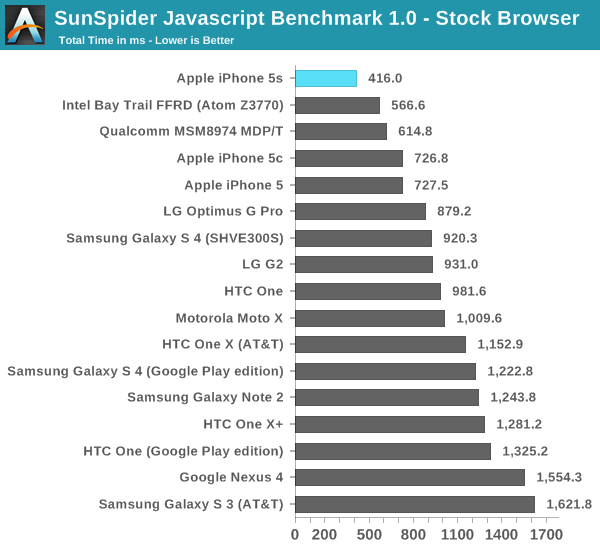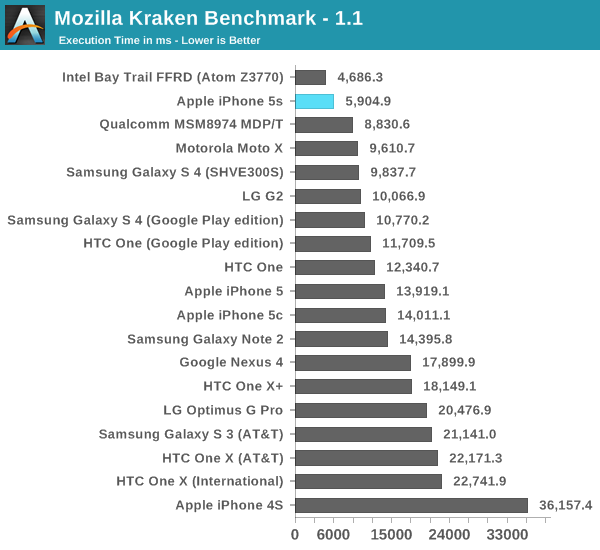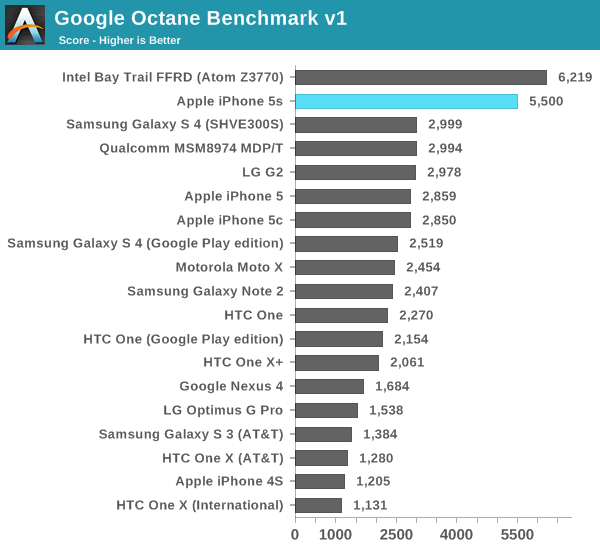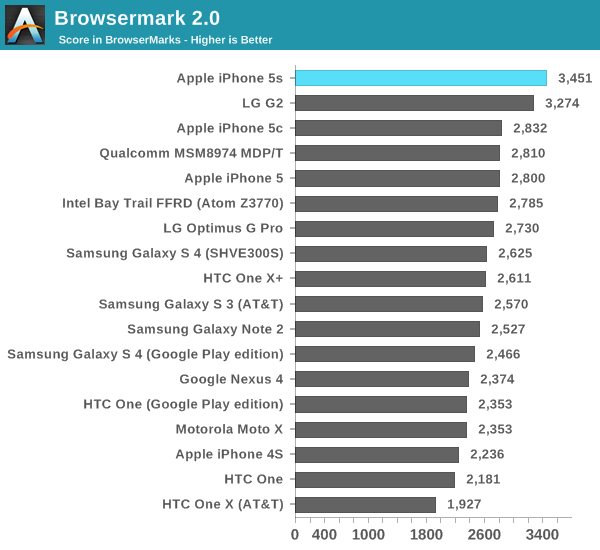The iPhone 5s Review
by Anand Lal Shimpi on September 17, 2013 9:01 PM EST- Posted in
- Smartphones
- Apple
- Mobile
- iPhone
- iPhone 5S
CPU Performance
For our cross-platform CPU performance tests we turn to the usual collection of Javascript and HTML5 based browser tests. Most of our comparison targets here are smartphones with two exceptions: Intel's Bay Trail FFRD and Qualcomm's MSM8974 Snapdragon 800 MDP/T. Both of those platforms are test tablets, leveraging higher TDP silicon in a tablet form factor. The gap between the TDP of Apple's A7 and those two SoCs isn't huge, but there is a gap. I only include those platforms as a reference point. As you're about to see, the work that Apple has put into the A7 makes the iPhone 5s performance competitive with both. In many cases the A7 delivers better performance than one or both of them. A truly competitive A7 here also gives an early indication of the baseline to expect from the next-generation iPad.
We start with SunSpider's latest iteration, measuring the performance of the browser's js engine as well as the underlying hardware. It's possible to get good performance gains by exploiting advantages in both hardware and software here. As of late SunSpider has turned into a bit of a serious optimization target for all browser and hardware vendors, but it can be a good measure of an improving memory subsystem assuming the software doesn't get in the way of the hardware.

Bay Trail's performance crown lasted all of a week, and even less than that if you count when we actually ran this benchmark. The dual-core A7 is now the fastest SoC we've tested under SunSpider, even outpacing Qualcomm's Snapdragon 800 and ARM's Cortex A15. Apple doesn't quite hit the 2x increase in CPU performance here, but it's very close at a 75% perf increase compared to the iPhone 5. Update: Intel responded with a Bay Trail run under IE11, which comes in at 329.6 ms.
Next up is Kraken, a heavier js benchmark designed to stress more forward looking algorithms. Once again we run the risk of the benchmark becoming an optimization target, but in the case of Kraken I haven't seen too much attention paid to it. I hope it continues to fly under the radar as I've liked it as a benchmark thus far.

The A7 falls second only to Intel's Atom Z3770. Although I haven't yet published these results, the 5s performs very similarly to an Atom Z3740 - a more modestly clocked Bay Trail SKU from Intel. Given the relatively low CPU frequency I'm not at all surprised that the A7 can't compete with the fastest Bay Trail but instead is better matched for a middle of the road SKU. Either way, A7's performance here is downright amazing. Once again there's a performance advantage over Snapdragon 800 and Cortex A15, both running at much higher peak frequencies (and likely higher power levels too, although that's speculation until we can tear down an S800 platform and a 5s to compare).
Compared to the iPhone 5, the 5s shows up at over 2.3x the speed of last year's flagship.
Next up is Google's Octane benchmark, yet another js test but this time really used as a design target for Google's own V8 js engine. Devices that can run Chrome tend to do the best here, potentially putting the 5s at a disadvantage.

Bay Trail takes the lead here once again, but again I expect the Z3740 to be a closer match for the A7 in the 5s at least (it remains to be seen how high the iPad 5 version of Cyclone will be clocked). The performance advantage over the iPhone 5 is a staggering 92%, and obviously there are big gains over all of the competing ARM based CPU architectures. Apple is benefitting slightly from Mobile Safari being a 64-bit binary, however I don't know if it's actually getting any benefit other than access to increased register space.
Our final browser test is arguably the most interesting. Rather than focusing on js code snippets, Browsermark 2.0 attempts to be a more holistic browser benchmark. The result is much less peaky performance and a better view at the sort of moderate gains you'd see in actual usage.

There's a fair amount of clustering around 2500 with very little differentiation between a lot of the devices. The unique standouts are the Snapdragon 800 based G2 from LG, and of course the iPhone 5s. Here we see the most modest example of the A7's performance superiority at roughly 25% better than the iPhone 5. Not to understate the performance of the iPhone 5s, but depending on workload you'll see a wide range of performance improvements.










464 Comments
View All Comments
qristheone - Monday, September 23, 2013 - link
If that was the case why can moto x be made in america and still make a profit? clearly apple is just raping people.robbie rob - Monday, September 23, 2013 - link
I don't know where you're getting your info, but in the last year only TWO handset makers made a profit: Samsung and Apple. All others broke even or lost money. Broke even means made money, but by the time you pay everyone plus cost of manufacturing you didn't lose money - but you didn't bank any either.http://www.neowin.net/news/analysts-apple-and-sams...
qristheone - Monday, September 23, 2013 - link
the real probelm with these test is ios 7 has open gl 3.0 and android has it only on 4.3. most of these phones do not have android 4.3 infact i doubt that any of these phones tested had 4.3 when running it.for those who dont know open gl is OpenGL (Open Graphics Library) is a cross-language, multi-platform application programming interface (API) for rendering 2D and 3D computer graphics. The API is typically used to interact with a Graphics processing unit (GPU), to achieve hardware-accelerated rendering.
NekoTipcat - Saturday, November 30, 2013 - link
Well yes iOS supports oGL ES 3.0 but only the iPhone 5s's gpu supports itSo the Real "Problem" resides on iOS 7 and iDevices as well
whatsa - Tuesday, September 24, 2013 - link
NiceAs its all about apps - lol
it would be more interesting to see the performance gain there
as it will be many years before you see a native 64bit majority in the store.
even though the tests bode well for the future everyday usage it will be the
more generic apps that define its performance "today"
lhlan - Wednesday, September 25, 2013 - link
Section on A7 dual core vs quadcore design: you emphasized the A7's power efficiency advantage (lack of proper power gating on quad-core parts), as well as performance neutral factor - two cores at full speed is not slower than quad-core at so-so speed! A reference to the CPU section of MotoX review was made to back-up this point.Closer investigation of the MotoX review shows different picture: while performance can be comparable at best, the argument on power efficiency is so in favour of quad-core! It says running two cores at full high speed requires "ton of voltage", while running four core at 1.2GHz doesn't need that much power, hence more power efficiency.
In the end, do we have empirical evidence as to which design (two vs. four) saves more power?
128bit - Thursday, September 26, 2013 - link
First time knows that IPhone 5s comes with 1570 MAh battery.Anand ur the best keep the good job
rogekk - Thursday, September 26, 2013 - link
may pick myself up one after reading this review coupled with is african view about the iphonehttp://techjaja.com/the-reviews/iphone-5s-review/2...
newandroidfan - Saturday, September 28, 2013 - link
Tired of reading big ass reviews? Never get the info you need the most? Read the full review of the iPhone 5s and iPhone 5c with Full phone specifications only here http://goo.gl/QrGSPoanxyandy - Monday, September 30, 2013 - link
Hmm! If this beauty is as good as it looks here, I'm afraid I won't even be considering the iPhone 5S! http://versus.com/en/sony-xperia-z1-mini-vs-apple-...Xperia Z1 Mini - same(ish) size, excellent features and hardware!